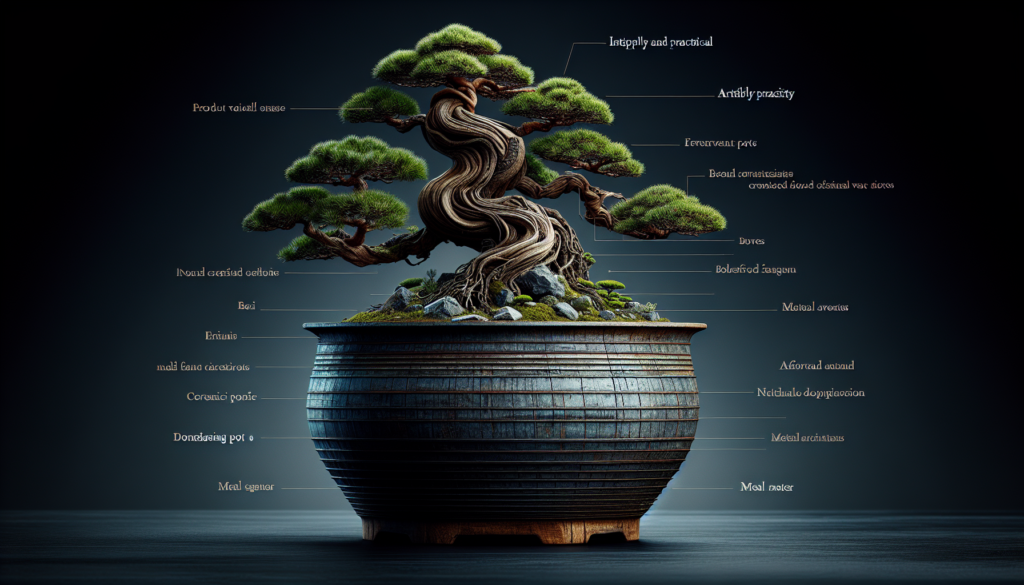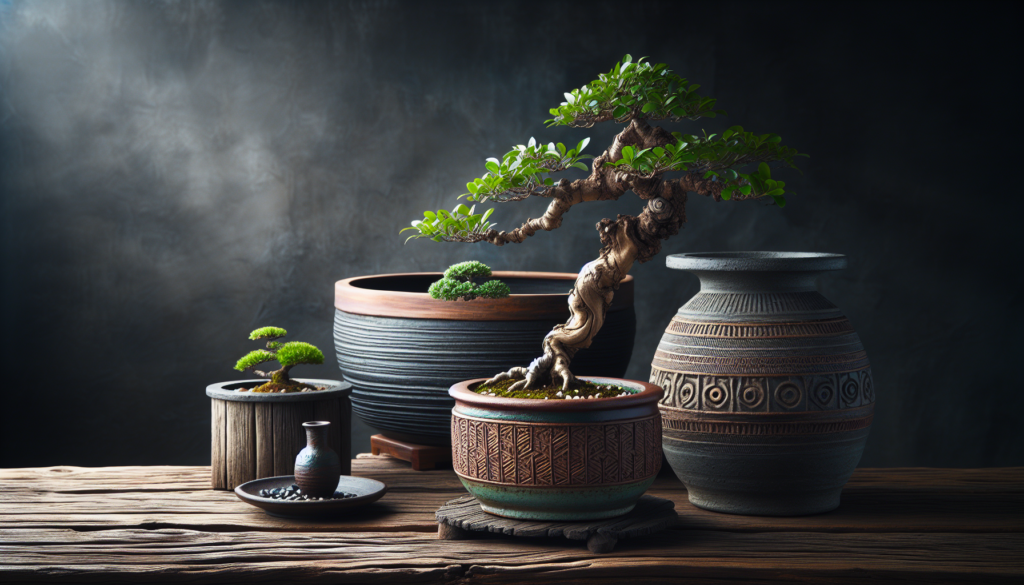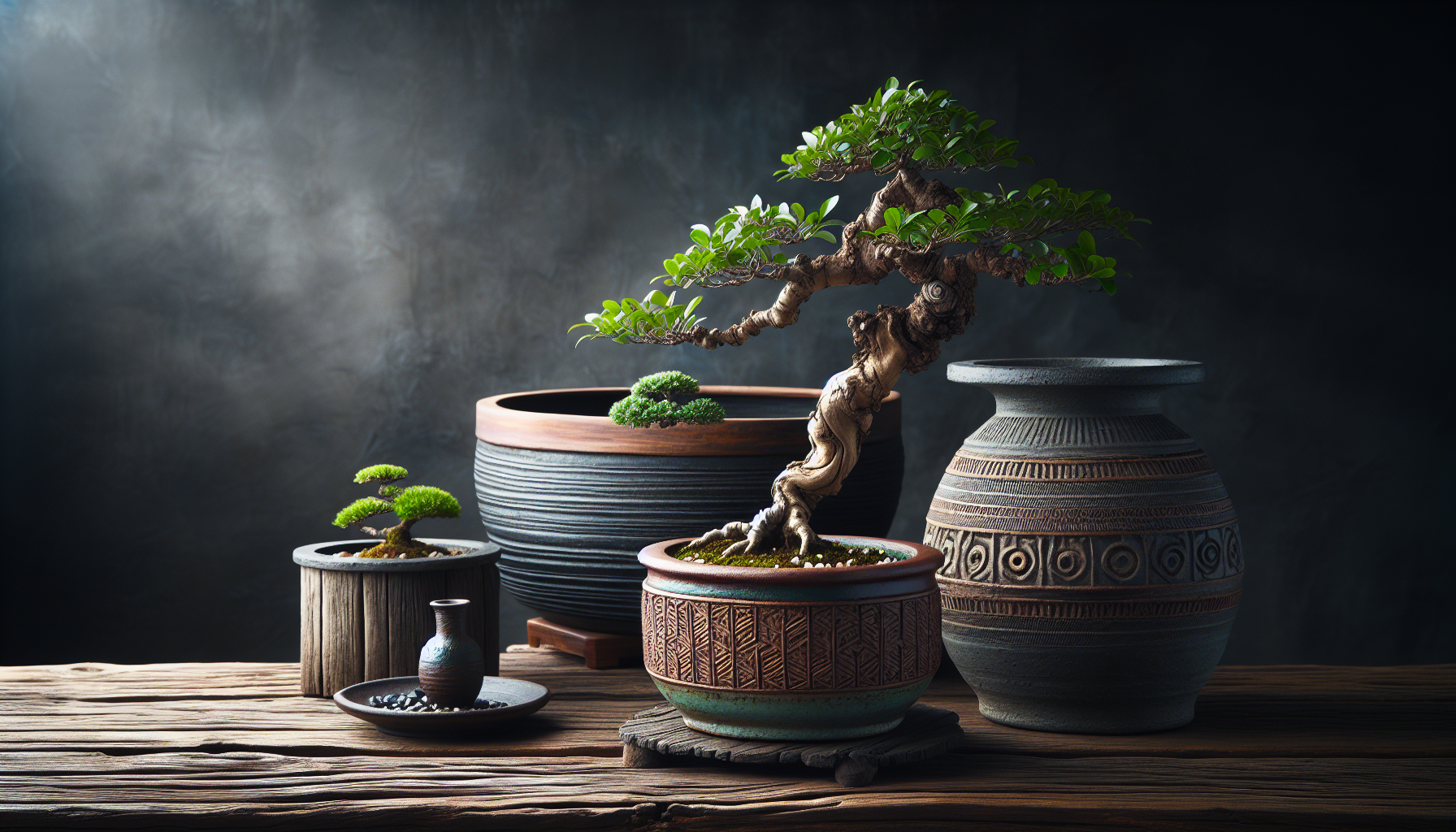So, you’ve decided to take up the art of bonsai and now you’re on the hunt for the perfect pot to showcase your miniature masterpiece. Well, look no further, because in this article, we’ll be exploring the key factors to consider when selecting a bonsai pot – namely, the material, size, and style. Whether you’re a beginner looking to dip your toes into the world of bonsai or a seasoned enthusiast seeking to add to your collection, understanding the importance of these factors will ensure your bonsai thrives in the most suitable home. So, let’s get started on the exciting journey of finding the ideal pot for your bonsai!

Understanding the Importance of Bonsai Pot Material
Bonsai pots play a vital role in the overall health and aesthetics of a bonsai tree. While size and style are important considerations, the choice of material is equally significant. The material used for bonsai pots can have a profound impact on the tree’s health, as well as its visual appeal. It is essential to understand the various material options available and their characteristics to make an informed decision when selecting a bonsai pot.
Material Types for Bonsai Pots
There are several material types commonly used for bonsai pots. Each material comes with its own set of characteristics and features that can greatly influence the overall experience of growing a bonsai tree. Let’s take a closer look at some of the most commonly used materials for bonsai pots and compare their key traits.
Ceramic Bonsai Pots
Ceramic bonsai pots are widely popular among bonsai enthusiasts for their durability and aesthetic appeal. These pots are made from fired clay, which gives them a sturdy structure and an elegant appearance. The high firing temperatures result in pots that have excellent water retention properties and provide a stable environment for the tree’s roots.
The benefits of using ceramic pots include their ability to regulate temperature and moisture levels, which promotes healthy root growth. However, ceramic pots can be heavy and prone to cracking if mishandled. It’s important to handle them with care and avoid sudden temperature changes to prevent any damage.
Ceramic bonsai pots are commonly used for various bonsai styles and can enhance the visual impact of the tree’s overall presentation.
Plastic Bonsai Pots
Plastic bonsai pots have gained popularity in recent years due to their lightweight nature and affordability. These pots are made from durable plastics and are available in a wide range of shapes and sizes. Plastic pots offer excellent drainage properties, ensuring that the roots do not become waterlogged.
The advantages of plastic bonsai pots include their ease of transportation, resistance to cracking, and the ability to retain moisture without becoming waterlogged. However, plastic pots may not provide the same level of insulation as ceramic pots, which could be a concern in extreme weather conditions.
Plastic bonsai pots are particularly suitable for beginners or enthusiasts who prefer a more budget-friendly option. They are also an excellent choice for tropical bonsai trees that require higher humidity levels.

Mica Bonsai Pots
Mica bonsai pots are a relatively newer addition to the bonsai pot market, and they offer a unique set of features. These pots are made from a blend of mica, a mineral known for its insulating properties, and polyethylene, a durable plastic. The combination of these materials results in pots that are lightweight, durable, and provide excellent insulation.
The advantages of using mica pots include their resistance to cracking, their ability to insulate the roots against extreme temperature fluctuations, and their lightweight construction. However, mica pots can be more expensive compared to other materials, which may be a determining factor for some bonsai enthusiasts.
Mica bonsai pots are particularly suitable for outdoor bonsai trees that require protection against temperature variations and benefit from insulation.
Concrete and Cement Bonsai Pots
Concrete and cement bonsai pots have a unique, rustic charm that appeals to many bonsai enthusiasts. These pots are made from a mixture of cement, sand, and aggregate, resulting in a durable and stable container for bonsai trees. Concrete and cement pots are known for their strength and ability to withstand harsh weather conditions.
The strengths of concrete and cement pots include their durability, stability, and longevity. They can withstand extreme temperatures and are less prone to cracking compared to other materials. However, these pots can be heavy and may not be suitable for frequent transportation.
Concrete and cement bonsai pots are often used for larger bonsai trees or as accent pieces in outdoor garden displays.
Wooden Bonsai Pots
Wooden bonsai pots offer a traditional and natural look that complements the aesthetic appeal of many bonsai trees. These pots are crafted from different types of wood, such as cedar or pine, and provide a unique and organic environment for the tree’s roots. Wooden pots often require additional sealing to prevent water damage.
The benefits of using wooden bonsai pots include their natural appearance, which enhances the overall harmony between the tree and its container. Wooden pots also have good insulating properties and can provide a stable environment for the roots. However, they require regular maintenance, such as resealing and protection against pests.
Wooden bonsai pots are commonly used for deciduous or flowering bonsai trees and are especially suited to a more traditional or rustic style.
Choosing the Right Material Based on Bonsai Type
The type of bonsai tree you have plays a significant role in determining the most suitable material for its pot. Different bonsai types have varying requirements for moisture retention, insulation, and stability.
For example, tropical bonsai trees, which thrive in high humidity environments, may benefit from a plastic bonsai pot that retains moisture without becoming waterlogged. On the other hand, coniferous bonsai trees, which prefer cooler temperatures, may be better suited to a ceramic pot that offers insulation and stability.
It is essential to understand the specific needs of your bonsai tree and select a pot material that can provide the optimal growing conditions.
Environmental Impact of Bonsai Pot Materials
As the interest in bonsai continues to grow, it is important to consider the environmental impact of the materials used for bonsai pots. Some materials have a more significant environmental footprint than others due to their production processes or non-biodegradable properties.
Ceramic pots, for instance, require high-temperature firing processes that consume a significant amount of energy. However, they are often made from natural clay materials that can be sourced sustainably.
Plastic pots, on the other hand, are generally made from non-renewable resources and take a considerable amount of time to decompose. However, some manufacturers are now producing plastic pots from recycled materials or using biodegradable plastics to reduce their environmental impact.
When selecting a bonsai pot material, it is worthwhile to consider more sustainable options or research manufacturers that prioritize eco-friendly production methods.
Impact of Material on Pricing of Bonsai Pots
The material used for bonsai pots can also influence their price. Different materials require various manufacturing processes, and their availability can affect the overall cost.
Ceramic pots, due to their intricate designs and firing processes, tend to be more expensive than plastic or wooden pots. Similarly, mica pots, with their unique blend of materials, may also have a higher price tag.
When evaluating the value of a bonsai pot, it is essential to consider not only the material but also the longevity and durability it offers. A higher-priced pot made from a durable material may prove to be a better investment in the long run.
In Conclusion
The choice of bonsai pot material is not one to be taken lightly. Understanding the characteristics, advantages, and disadvantages of different materials can help you make an informed decision that will contribute to the health and aesthetic appeal of your bonsai tree. Consider the specific needs of your bonsai type, the environmental impact of the material, and the longevity and value of the pot when selecting the perfect container for your bonsai. By choosing the right material, you can create the ideal environment for your bonsai tree to thrive and enjoy the beauty of this ancient art form.








